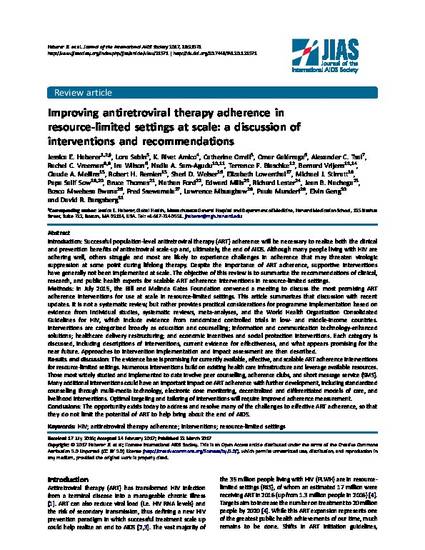
- Highly active Antiretroviral Therapy--methods,
- HIV infections Patients,
- Antiretrovirals
INTRODUCTION:
Successful population-level antiretroviral therapy (ART) adherence will be necessary to realize both the clinical and prevention benefits of antiretroviral scale-up and, ultimately, the end of AIDS. Although many people living with HIV are adhering well, others struggle and most are likely to experience challenges in adherence that may threaten virologic suppression at some point during lifelong therapy. Despite the importance of ART adherence, supportive interventions have generally not been implemented at scale. The objective of this review is to summarize the recommendations of clinical, research, and public health experts for scalable ART adherence interventions in resource-limited settings. METHODS:
In July 2015, the Bill and Melinda Gates Foundation convened a meeting to discuss the most promising ART adherence interventions for use at scale in resource-limited settings. This article summarizes that discussion with recent updates. It is not a systematic review, but rather provides practical considerations for programme implementation based on evidence from individual studies, systematic reviews, meta-analyses, and the World Health Organization Consolidated Guidelines for HIV, which include evidence from randomized controlled trials in low- and middle-income countries. Interventions are categorized broadly as education and counselling; information and communication technology-enhanced solutions; healthcare delivery restructuring; and economic incentives and social protection interventions. Each category is discussed, including descriptions of interventions, current evidence for effectiveness, and what appears promising for the near future. Approaches to intervention implementation and impact assessment are then described. RESULTS AND DISCUSSION:
The evidence base is promising for currently available, effective, and scalable ART adherence interventions for resource-limited settings. Numerous interventions build on existing health care infrastructure and leverage available resources. Those most widely studied and implemented to date involve peer counselling, adherence clubs, and short message service (SMS). Many additional interventions could have an important impact on ART adherence with further development, including standardized counselling through multi-media technology, electronic dose monitoring, decentralized and differentiated models of care, and livelihood interventions. Optimal targeting and tailoring of interventions will require improved adherence measurement. CONCLUSION:
The opportunity exists today to address and resolve many of the challenges to effective ART adherence, so that they do not limit the potential of ART to help bring about the end of AIDS.

Copyright: © 2017 Haberer JE et al; licensee International AIDS Society. This is an Open Access article distributed under the terms of the Creative Commons Attribution 3.0 Unported (CC BY 3.0) License (http://creativecommons.org/licenses/by/3.0/), which permits unrestricted use, distribution, and reproduction in any medium, provided the original work is properly cited.